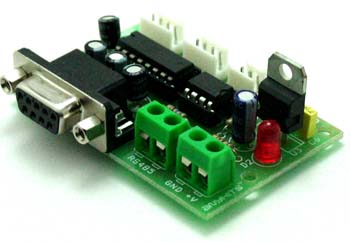An Unbiased View of Rs485 Cable
페이지 정보

본문

A write collision occurs when a byte is written to the SPI data register, SPDR, while data is being exchanged. While running this program, the parity settings of Mosaic Terminal may be adjusted, and in each case the message that matches current settings will appear clearly while the other messages will appear garbled. We can gain insight into the operation of the RS232 protocol by examining the signal connections used for the primary serial port in Table 9 6. The transmit and receive data signals carry the messages being communicated between the QScreen Controller and the PC or terminal. The RS485 connections are not brought out to the Serial 1 Connector. In this case, cable connections may be made to Serial 1 on either the 10-pin Serial Communications Header or the Serial 1 Connector. The RS232 DB-9M connector is compatible as a PC comport and the RS422/485 DB-9F follows the SMPTE pinout arrangement common to multimedia equipment. The QScreen Controller’s transmit data signal TxD1 (pin 2 on the 9-pin serial connector) is connected to the terminal’s receive data signal RxD (pin 2 on its 9-pin connector).
If it doesn’t, confirm that the terminal’s baud rate is correct by selecting the Comm item in the Settings menu of the Mosaic Terminal program, and click on 115200 baud. The terminal’s serial receiver chip re-inverts the signal to its positive sense. Rather, the transmitter and receiver must be communicating using a known baud rate, or bit frequency. Now select the "Comm" item in the "Settings" menu of the Terminal program, and click on 1200 baud (or whatever baud rate you selected in the command above). Both the local and remote UARTs must be configured for the same baud rate. There are different sets of standard baud rates in use depending on the application. If your application requires communicating with a device that expects to receive a parity bit, the generation of a parity bit and selection of even or odd parity, and whether there are seven or eight data bits in each byte, is performed by setting or clearing bits in the configuration registers SCI0CR1 for Serial1 and SCI1CR1 for Serial2. The serial interface is asynchronous, meaning that there is no clock transmitted along with the data. The USE.SERIAL2 command means that the operating system’s terminal interface now communicates via Serial2.
When the keyword name is received by the Silence() routine running in the slave, the slave PDQ Board executes RS485Transmit() to send an acknowledgment to the master (which should now be listening to the serial bus to accept the acknowledgment). A single master can broadcast commands to all the slaves, and can direct commands to an individual slave using its unique address. In the simplest scheme, all RS485 transceivers come up in receive mode when the interface is initialized, and each transceiver node has a unique address known to it and the master. Care must be taken when changing an RS485 node from transmit mode to receive mode, or visa versa. You can use one or both of the PDQ Board’s RS485 links to create such a multi-drop serial network. So, for eight data bits with a parity bit, M would be set (equal to one) in order to add an extra bit to each byte transmitted, and PE would be set in order to make that extra bit be used as a parity bit. Any of these conditions may generate an interrupt if the SPIE (SPI interrupt enable) bit in the SPCR control register is set. Given a properly wired network and a properly configured SPCR control register, a master device may transmit a message by simply storing the byte to the SPDR data register.
In the most common multi-drop RS485 protocol, one computer is designated as a master and the rest of the computers or devices on the serial bus are designated as slaves. In the most common multi-drop RS-485 protocol, one computer is designated as a "master" and the rest of the computers or devices on the serial bus are designated as "slaves". The master and slave could even exchange ascii QED-Forth operating system commands. At any given time, only the master and a single active slave communicate. You can implement the slave select lines by configuring Port A pins as outputs. To ensure that no two devices drive the network at the same time, it is necessary that each slave device be able to disable its own RS485 data transmitter. RS485 uses the same differential signaling scheme as RS422, and hence has the same superior signal-to-noise characteristics and range described above. We feature RS232, RS422, RS485, USB, and ethernet devices using copper and fiber. You may use nonstandard baud rates if both devices support them. The PDQ Board's two serial ports support limited use of generating a parity bit. The Serial1 and Serial2 ports are is supported by the HCS12's dual on-chip hardware UARTs, and do not require interrupts to work properly.
If you have any inquiries with regards to exactly where and how to use rs485 cable, you can speak to us at our own web-site.
- 이전글Microneedling Treatment: A Comprehensive Guide 24.05.30
- 다음글Checking out Innovative Small business Strategies for Aspiring Business owners 24.05.30
댓글목록
등록된 댓글이 없습니다.



